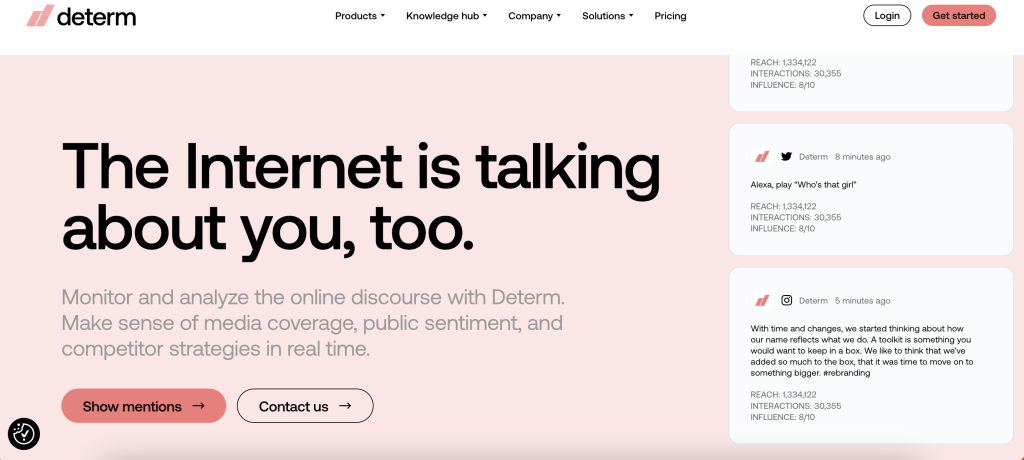Sometimes it can be a bit intimidating to come up with creative ideas for your new video marketing strategy. A lot of trial and error goes into the process of finding out what gels best with your target audience.
? Read Creating a Marketing Strategy that Works: Benefits, Steps, Tools
Well, getting customers to tell you exactly what kind of content they like isn’t that hard at all. Social listening can help you get good insights into the different ways of improving your video marketing plan. And the best thing is that this opinion is completely unbiased.
Here, we will first go through the differences between social listening and social media monitoring. After that, we’ll discuss how you can leverage social listening to strengthen your video marketing strategy.
Let’s dig in!
Difference Between Social Listening and Social Media Monitoring
Social media monitoring definition
There is hardly a better source of customer feedback than social media platforms. In fact, 45% of internet users check social media before they make a purchasing decision. This is why it’s crucial to monitor social media channels all the time, and take the findings into concern when making business decisions.
Social media monitoring involves identifying and monitoring mentions, hashtags or keywords relevant to your brand or industry. This process is rather easy when your brand is tagged or mentioned somewhere on social media. But things get a bit more complicated when these keywords are mentioned in random conversations, without tags. This is where social media monitoring tools step in.
Social media monitoring has a very simple objective, in fact. It helps you monitor precisely when something you’re interested in is mentioned. In that way, you can react immediately, respond to a disappointed customer, prevent a crisis from happening, and most importantly – learn a lot about your customers.
Read 7 Questions to Probe Your Online Marketing Strategy

What exactly does social listening entail
Just as the name suggests, social listening is the process of listening to different online conversations that can be relevant to your industry or brand. How is that different from social media monitoring, you might ask?
Social media monitoring is about observing, collecting, and getting involved in individual conversations. Social listening, on the other hand, is about how your brand, products and services, competitors, markets, and representatives are deliberated. So social listening includes monitoring and taking active measures based on the findings.
There are no separate conversations with social listening. Instead, you indulge in large quantities of social data. The result you get is valuable insights into the consumers’ perception of your competitors, company, and social events.
All-inclusive social listening includes direct product or brand mentions, competitors, industry, and topics your target audiences generally engage with. Social listening also typically pays attention to the language, cultural cues, and sentiments in the posts and tweets your audiences share online.
Read Complete Guide to Social Listening: Proven Hacks, Strategies, and Tools
How is Social Listening Beneficial for Your Video Marketing Strategy
The starting point for any video marketing strategy should be the knowledge that you have about your target audience. What are their habits, what they like and dislike, their problems and worries, what they react to, etc. All of this information will help you make video content that will best speak to them. And if specific content speaks directly to a customer, solving their worries, it’s highly likely that it will provoke interest.
This is where social listening tools come in handy. If there’s one thing they provide, it’s data. A lot of them. And the best thing is that you usually get this data in a single dashboard, with easily digestible reports.
Read How to Create a Video Sales Funnel with Social Media

Social listening/monitoring tools
Social listening and social monitoring tools enable you to track certain terms of interest on multiple channels through a single dashboard. In this way, you can track online mentions of your brand name, competitors, industry trends, etc. In the end, this data helps you foresee trends, learn from your competitors and influence your brand image.
So a good social listening tool will provide metrics like:
- mentions over time
- reach
- engagement
- sentiment
- impressions
- top locations
- word cloud mentioning words that appear most frequently around your query
- top languages
And all of that is available by source – websites, social media channels, forums, specific channels, etc. If you take another look at the list, you’ll see that this is incredible data that can help you plan your next video.
For instance, you might find that as the vacation season starts, more of your followers will be sharing content relevant to travel, family gatherings, and baking. So you might want to jump on the bandwagon and do a video somehow combining your product/service with vacation. Also, the general sentiment of your followers will shift from feeling completely relaxed in the summers to being a bit more stressed as regular life gets busier. So you’ll maybe think of funny or relaxing video content, with the potential to become viral.
The ideal situation here will be picking up on insights and trends specific to the niche you are serving. If you perform this exercise regularly, it will get easier for you to dissect seasonality and know how things keep changing with time.

Using Social Listening for Video Marketing Strategy
The first step you should do is to make insights from social listening tools an integral part of your content planning procedure.
Next, be aware of the things popular on the internet. Track relevant takeaways for your company and scopes that add value to conversations about your brand. Also, pay close attention to hashtags, emojis, vocabulary, and other important cultural cues included in everything that is being shared by your target audiences. Let’s check what all of this will bring to you.
Getting hold of new leads
An ideal route to take is offering people everything they need. Use the lessons you have learned from social listening to ideate new video campaigns utterly relevant to your target customers.
In this context, it would be best to start by monitoring how your audience reacts to what you have at the moment. After that, include monitoring what your competitors are doing and comparing with their results. This is the easiest way to get a better grasp of what kind of video content works better because you’re targeting the same audience. Once you’ve figured out which direction is better to take, make sure to invest a lot more into engaging with your potential buyers on social media. This will additionally spread your reach and potentially bring new leads.
Using the power of positive feedback
If you notice a lot of positive feedback after the introduction of a new product from your end, double down on this opportunity. The best way to do so is to make videos to highlight and promote different aspects people love the most about the product or the service you have newly launched in the market. You can do it hassle-free by using an online professional video editor. This type of content will surely resonate, considering that you are already getting positive feedback from many individuals.
Further, you can use the audience’s reaction to gauge your success. This procedure is specifically beneficial when, as a team, you are experimenting with new video series and styles.
You can use the metrics of a social listening tool to understand what people think about the video, whether the sentiment around it is good or bad, and which words they mainly use when talking about it (and if they talk about it at all). This will make it easier for you to understand the reach and the direction of your video marketing strategy and will push you to rethink your steps if necessary.
Always make sure to use the same language your satisfied consumers use. When making a script, formulate the benefits and features in the same way as your customers did. If you frame all your messages this way, there are higher chances of striking a chord with the new prospects.
Read Online Reviews: the Ultimate Guide on How to Track and Handle Them
Using the power of negative feedback
This will be your chance to address other types of feedback on a much larger scale. You have already responded to these consumers individually. Just take it a step further and create videos on the common problems some people face.
This type of content is simple to create and it’s very useful since you could be solving problems for even more people than you’re aware.
It is best to catalog data for consumers who are unhappy with your products and services. Next time, when you have newer features to showcase in your products and services that you know might satisfy them, create a video announcing this.
You can even go a bit further and acknowledge the problems that your latest release can solve. This is one of the best ways of showing unhappy customers that they are being heard and taken care of.
Going beyond your brand
Apart from the ways mentioned above, there are various other options that you can use to find inspiration based on the insights you accumulate from social listening.
First, pay close attention to competitors, close-enough businesses, and even brands outside the industry you serve with engaging videos that you like. Have a close look at the best-performing and worst-performing videos. This will help you understand the type of videos you need to create.
Taking care of everything your consumers are saying outside your brand will help you make some smart video decisions. Current events, pop culture, and social causes can serve as catalysts for improvising and creating new content as a part of content marketing that will enhance your brand reputation. The only thing you need to do here is to identify the subject matter your audience is actually interested in and can easily engage with online.
Taking this approach will help you get to the new areas of content not addressed previously, and this will help you reach new audiences and capture more viewer attention.
The Bottom Line
It’s simple – the better you know and understand your audience, the more likely you will be able to create content that resonates with them.
Social listening can help you create a lot of content that will fill up your content calendar for several months. The key here is listening carefully to find out exactly what people desire. And find inspiration in what resonates with your audience the best.



